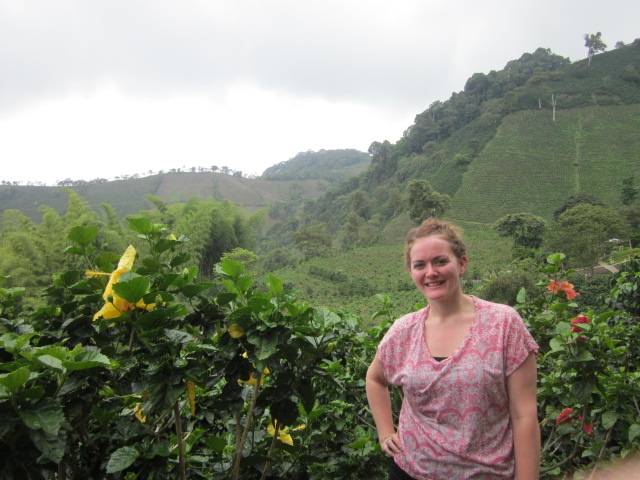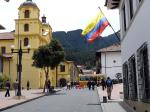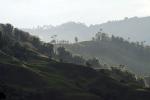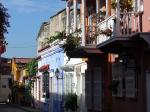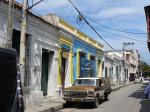I cannot imagine that anybody who has read a Gabriel Garcia Marquez novel has not at least been tempted to add Colombia to their bucket-list. Since my first forays into Latin literature, I have been intrigued by the country, swept up in the romance and magic realism of Marquez’ Colombia. That said it has taken me a shamefully long time to visit, and I was thrilled to finally put that right. The rare treat of a direct flight from London to South America, took us from London Heathrow’s sparkling new Terminal 2 to Bogotá. The unearthly arrival time of 0440 (which in fact turned out to be 0340 – the winds must have been in our favour) was actually a blessing in disguise: no queues at immigration and we reached the hotel in what was still deemed to be night-time enough to allow a few hours’ kip before our morning city tour.
Bogotá is a large, modern and chaotic city, full of life. We stayed in the leafy, residential district of Zona Rosa in the wealthy north, which is pleasant to walk around and offers ample choice for evening entertainment in terms of restaurants, bars and cafes. The beautiful historic centre of La Candelaria is limited to a few streets set around Plaza Bolivar with its cobblestone streets, multitude of churches, museums and brightly-painted colonial houses. I would have liked to see the city from the top of Monserrate Hill, reached by funicular, cable car (or for the hardy by foot), the views are said to be spectacular, but alas we were in town over the weekend when locals also like to enjoy the vista from Monserrate and queues are long.
The coffee region
From Bogotá we flew to Pereira in the heart of the coffee triangle: huge plantations, lush green valleys, impossibly tall wax palm trees and beautiful haciendas define the landscape. The small, colourful towns of Filandia and Salento were a highlight, as was riding through the picturesque Cocora Valley. For me the journey from Salento to the Cocora Valley, through the magnificent countryside, stood in the back of a Willys Jeep, wind blowing through my hair, was rural Colombia at its best! The mild, spring-like climate of the coffee region makes it the perfect place to unwind; enjoy the natural beauty and the fantastic coffee!
Cartagena
Cartagena was our next stop and no trip to Colombia would be complete without a visit to the most romantic of cities. Cartagena somehow managed to exceed even the exceedingly high expectations I had placed upon it – without a doubt one of Latin America’s most vibrant and beautiful spots. The old walled city is a rabbit warren of cobbled streets, exquisitely preserved colonial architecture steeped in history; all overlooking a stunning stretch of Caribbean coast. It is a place to throw away the map and get lost, or hail a horse drawn carriage for a tour of the city, evocative of times gone by. The beautiful Casa San Agustin makes the perfect base for exploring the city.
Tayrona
From Cartagena I continued west along the Caribbean coast, through Barranquilla (hometown to Shakira and South America’s biggest Carnival celebrations outside of Brazil) and Santa Marta to Tayrona National Park. Tayrona is an area of stunning natural beauty; lush tropical jungle meets the Caribbean coast on some of South America’s finest shores. You can enjoy wonderful hikes or relax on the white sand beaches. It is possible to stay within the park at the lovely Eco-habs (or just outside as I did).
Santa Marta
I flew back to Bogotá from nearby Santa Marta but not before spending time there, in South America's oldest surviving city. The old town centres around the newly renovated Parque de los Novios, and contains a quieter, more understated charm than Cartagena. It is a good base for seeing many of the areas highlights. The drier heat and evening breeze make it a lovely city to wander around at night; there are plenty of boutique hotels, restaurants and bars to take advantage of in the colonial centre.
Villa de Leyva
The final leg of my journey was to Villa de Leyva, around a four hour drive north of the capital. One of Colombia’s most famous and best-preserved colonial gems, Villa de Leyva feels like a leap back in time. The narrow streets fill at weekends with Bogotanos escaping the big city, but during the week the cobbled streets, red-tile-roofed, white-washed buildings and enormous central plaza can be enjoyed in a much more peaceful mode.
It is hard to pin-point what makes Colombia so special; the charming colonial cities, the stunning beaches, the very variety of landscapes, the friendliness of the people, the incredible coffee, the fascinating history, the magic realism? Every little thing adds to its unique charm.

